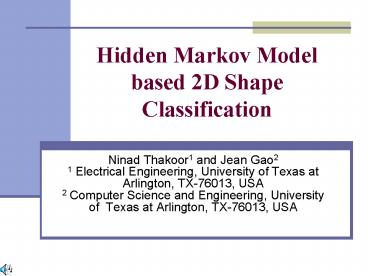Hidden Markov Model based 2D Shape Classification PowerPoint PPT Presentation
1 / 14
Title: Hidden Markov Model based 2D Shape Classification
1
Hidden Markov Model based 2D Shape Classification
- Ninad Thakoor1 and Jean Gao21 Electrical
Engineering, University of Texas at Arlington,
TX-76013, USA2 Computer Science and Engineering,
University of Texas at Arlington, TX-76013, USA
2
Introduction
- Problem of object recognition
- Shape recognition
- Shape classification
- Shape classification techniques
- Dynamic programming based
- Hidden Markov Model (HMM) based
- Advantages of HMM
- Time warping capability
- Robustness
- Probabilistic framework
3
Introduction (cont.)
- Limitations of HMM
- Unable to distinguish between similar shapes
- No mechanism to select important parts of shape
- Does not guarantee minimum classification error
- Proposed method deals with these limitations by
designing a weighted likelihood discriminant
function and formulates a minimum error training
algorithm for it.
4
Terminology
- S, set of HMM states. State of HMM at instance t
is denoted by qt. - A, state transition probability distribution. A
aij, aij denotes the probability of changing
the state from Si to Sj . - B, observation symbol probability distribution.
Bbj(o), bj(o) gives probability of observing
the symbol o in state Sj at instance t. - ?, initial state distribution. ? ?i, ?i gives
probability of HMM being in state Si at instance
t 1. - Cj is jth shape class where j1,2, ,M. HMM for
Cj can be denoted compactly as
5
Shape description with HMM
- Shape is assumed to be formed by multiple
constant curvature segments. These are hidden
states of HMM. - Each state is assumed to have Gaussian
distribution. Mean of the distribution is the
constant curvature of the segment. - Noise and details of the shape are standard
deviation of the state distribution.
6
HMM construction
- Preprocessing
- Filter the shape
- Normalize the shape length to T
- Calculate discrete curvature (,i.e., turn angles)
which will be treated as observations for the HMM - Initialization
- Gaussian mixture model with N clusters built from
unrolled example sequences
7
HMM construction (cont.)
- Training
- Individual HMM are trained by Baum-Welch
algorithm for varying number of states N - Model selection (,i.e, optimum N) is carried out
with Bayesian Information Criterion (BIC) - N is selected to maximize BIC.
8
Weighted likelihood (WtL) discriminant
- Motivation
- Similar objects can be discriminated by comparing
only part of the shapes - No point wise comparison is required for shape
classification - Maximum likelihood criterion gives equal
importance to all shape points - WtL function weights likelihoods of individual
observations such that the ones important for
classifications are weighted higher.
9
WtL discriminant (Cont.)
- Log likelihood of the optimal path Q followed by
observation O is given by - Where
- A simple weighted likelihood discriminant can
be defined as
10
WtL discriminant (Cont.)
- We use the following weighting function which is
sum of S Gaussian windows - Parameter pi,j governs the height, ?i,j controls
the position, while si,j determines spread of ith
window of jth class.
11
GPD algorithm
- Misclassification measure
- Cost function
- Re-estimation rule
12
Experimental results
- Plane shapes
- Classification accuracies (in )
13
Experimental results (cont.)
- Discriminant function comparison
HMM WtL
HMM ML
14
Questions?
- Please email your questions to ninad.thakoor_at_uta.e
du OR ninad.thakoor_at_ieee.org - Copy of the presentation is available at
- http//visionlab.uta.edu/ninad/acivs2005/
- THANK YOU!!!!!

